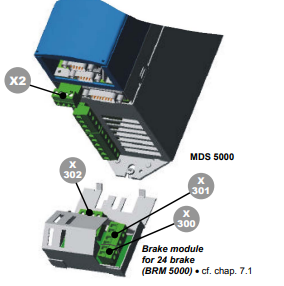
STOBERDESCRIZIONE Il regolatore indicatore Serie SG65 è adatto al controllo di variabili fisiche quali temperatura, pressione e livello di liquidi, gas e vapori negli impianti industriali o di processo. Il valore misurato della variabile fisica viene
• Connect the shield of the control lines on one side with reference ground of the reference value source (e.g., PLC or CNC).
• Shield, and, if necessary, twist reference value lines before installing.
4.2 RCD (Residual Current Protective Devices)
Network phases and neutral conductors are connected with the protective conductor via Y capacitors. When network voltage is
applied, a leakage current flows over these capacitors to the protective conductor. The greatest leakage current occurs during a
malfunction (asymmetric feedin via only one phase) and during power-on (sudden change in voltage). The maximum leakage
current due to asymmetric power feedin is 40 mA (network voltage of 400 V) for MDS inverters.
If RCD circuit breakers are necessary, the problem of power-on and off can be alleviated by using selective RCD circuit
breakers (switch-off delay) or RCD circuit breakers with increased tripping current (e.g., 300 or 500 mA). Only all-current
sensitive RCD circuit breakers may be used. Operation of several devices on one RCD circuit breaker is not recommended.
4.3 Power Connection
Protection via line circuit breakers in accordance with the values listed in chap. 2 (tripping characteristic C, in accordance with
EN 60 898) or suitable, delayed safety fuse.
Use class RK1 fuses for UL conformance: Class RK1 (e.g., Bussmann KTS-R-xxA / 600 V)
POSIDRIVE® MDS 5000 – Mounting Instructions STÖBER ANTRIEBSTECHNIK
4. Electrical Installation
16
4.4 Brake Module for 24 V Brake
The relay in the basic device for brake control is equipped with hardgold contacts. This relay is designed for control of an
electro-magnetic brake. The brake module for 24 V brake is required for control of a 24 V brake (BRM 5000). A thermally
monitored and short-circuit-proof, electronic semi-conductor switch is available for switching the brake. When Brake module for
24 V brake is placed between relay and brake, the integrated filter suppresses the switch-off reactions. This also increases the
lifespan of the relay contacts.
For a 230 VAC brake we also recommend control via
a coupling relay and not directly via the existing relay.
Installation
• Connect terminal X302 with terminal X2
(for connection cable, see chap. 4.7.2).
• Connect the external 24 V to the power supply of the
brake on X300 an (for pin allocation, see chap. 5.3).
• The brake and thermal contact lines installed in the motor
cable are connected to X301 (for pin allocation, see chap. 5.3).

POSIDRIVE® MDS 5000 – Mounting Instructions STÖBER ANTRIEBSTECHNIK
4. Electrical Installation
17
4.5 DC Link Coupling
If you are using axes in a plant which operate in a network of generators and motors, the DC link coupling (DC coupling) can be
advantageous. When the DC-coupling is used, the excess energy of other axes is made available as drive power instead of
converting this excess power into heat with a brake resistor. Remember that you will need a brake resistor which can absorb the
power peaks when all drives in the DC-link network brake at the same time.
DANGER
Danger of damage to devices! When single-phase and three-phase devices are coupled,
the single-phase devices will be destroyed. Use only three-phase devices for the DC link
coupling!
CAUTION
Danger of damage to devices! When one device within the DC-link coupling network fails,
the complete DC-link coupling network must be disconnected from the power network since
other devices in the DC-link coupling network may be damaged. Be sure to adhere to the
wiring of the ready-for-operation relay shown in chapter 4.5.1 (X1.1 and X1.2). When a
failure occurs, replace all devices of one group.
NOTE
Please note that the parameter A38 DC power-input must be set before the DC link
coupling will function correctly.
Group 1: A38 = 0: inactive
Group 2 and 3: A38 = 1: active
For more details, also see the description of the parameter.
4.5.1 Basic Circuit Diagram
The following diagram shows the basic circuiting of the DC-link coupling. The inverters can be coupled together in up to three
groups. The table in chapter 4.5.2 shows the possible combinations. The combination determines the types of power fuse and
DC-link fuse.
MDS/FDS
5000
MDS/FDS
5000
MDS/FDS
5000
MDS/FDS
5000
MDS/FDS
5000
MDS/FDS
5000
MDS/FDS
5000
X10 X10 X10 X10 X10 X10 X10
X1 X1 X1 X1 X1 X1 X1
X221
X221
X22 X22 X22 1
X22 X22
RB RB U+ U+ U+ U+ U- U- U- U- U+ U+ U+ U- U- U11 1 1 22 2 2 111 222
L1

NOTE
The certified version of the safety function is available for designs BG 0 to BG 2 as per EN
954-1 category 3. You will find the certificate under www.stoeber.de
The ASP 5001 may only be installed and repaired by STÖBER ANTRIEBSTECHNIK. This
is why you should include installation in the inverter with your order of the ASP 5001.
NOTE
When certified use is required, the inverter must be installed in a switching cabinet with a
protection rating of IP54.




























































































































